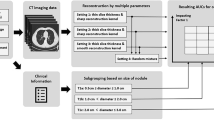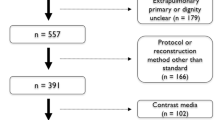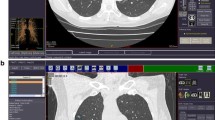Abstract
This study evaluates the accuracy of a computer-aided detection (CAD) application for pulmonary nodular lesions (PNL) in computed tomography (CT) scans, the ClearReadCT (Riverain Technologies). The study was retrospective for 106 biopsied PNLs from 100 patients. Seventy-five scans were Contrast-Enhanced (CECT) and 25 received no enhancer (NECT). Axial reconstructions in soft-tissue and lung kernel were applied at three different slice thicknesses, 0.75 mm (CECT/NECT n = 25/6), 1.5 mm (n = 18/9) and 3.0 mm (n = 43/18). We questioned the effect of (1) enhancer, (2) kernel and (3) slice thickness on the CAD performance. Our main findings are: (1) Vessel suppression is effective and specific in both NECT and CECT. (2) Contrast enhancement significantly increased the CAD sensitivity from 60% in NECT to 80% in CECT, P = 0.025 Fischer’s exact test. (3) The CAD sensitivity was 84% in 3 mm slices compared to 68% in 0.75 mm slices, P > 0.2 Fischer’s exact test. (4) Small lesions of low attenuation were detected with higher sensitivity. (5) Lung kernel reconstructions increased the false positive rate without affecting the sensitivity (P > 0.05 McNemar’s test). In conclusion, ClearReadCT showed an optimized sensitivity of 84% and a positive predictive value of 67% in enhanced lung scans with thick, soft kernel reconstructions. NECT, thin slices and lung kernel reconstruction were associated with inferior performance.





Similar content being viewed by others
Abbreviations
- 16xDEF:
-
Somatom definition AS 16-row CT scanner
- 16xEMO:
-
Somatom emotion 16-row CT scanner
- 64xDEF:
-
Somatom definition AS 64-row CT scanner
- CAD:
-
Computer-aided detection
- CECT:
-
Contrast-enhanced computed tomography
- CT:
-
Computed tomography
- FN:
-
False negative
- FP:
-
False positive
- HU:
-
Hounsfield Units
- NECT:
-
Non-enhanced computed tomography
- PACS:
-
Picture archiving and communication system
- PNL:
-
Pulmonary nodular lesions
- PPV:
-
Positive predictive value
- TN:
-
True negative
- TP:
-
True positive
- TPR:
-
True positive rate (sensitivity)
- V1:
-
CAD version 1
- V2:
-
CAD version 2
References
Jeong, Y. J., Yi, C. A., and Lee, K. S., Solitary pulmonary nodules: detection, characterization, and guidance for further diagnostic workup and treatment. AJR Am. J. Roentgenol. 188(1):57–68, 2007.
Ruparel, M. et al., Pulmonary nodules and CT screening: the past, present and future. Thorax 71(4):367–375, 2016.
Baldwin, D. R., Ten Haaf, K., Rawlinson, J., and Callister, M. E. J., Low dose CT screening for lung cancer. BMJ 359:j5742, 2017.
Oudkerk, M. et al., European position statement on lung cancer screening. Lancet Oncol. 18(12):e754–e766, 2017.
Liang, M. et al., Low-Dose CT Screening for Lung Cancer: Computer-aided Detection of Missed Lung Cancers. Radiology 281(1):279–288, 2016.
Horeweg, N. et al., Lung cancer probability in patients with CT-detected pulmonary nodules: a prespecified analysis of data from the NELSON trial of low-dose CT screening. Lancet Oncol. 15(12):1332–1341, 2014.
Girvin, F., and Ko, J. P., Pulmonary Nodules: Detection, Assessment, and CAD. Am. J. Roentgenol. 191(4):1057–1069, 2008.
Lo, S. B., Freedman, M. T., Gillis, L. B., White, C. S., and Mun, S. K., JOURNAL CLUB: Computer-Aided Detection of Lung Nodules on CT With a Computerized Pulmonary Vessel Suppressed Function. Am. J. Roentgenol. 210(3):480–488, 2018.
Milanese, G., Eberhard, M., Martini, K., Martini, I. V. D., and Frauenfelder, T., Vessel suppressed chest Computed Tomography for semi-automated volumetric measurements of solid pulmonary nodules. Eur. J. Radiol. 101:97–102, 2018.
Bankier, A. A. et al., Recommendations for Measuring Pulmonary Nodules at CT: A Statement from the Fleischner Society. Radiology 285(2):584–600, 2017.
Rubin, G. D., Lung Nodule and Cancer Detection in CT Screening. J. Thorac. Imaging 30(2):130–138, 2015.
Gupta, A., Saar, T., Martens, O., and Moullec, Y. L., Automatic detection of multisize pulmonary nodules in CT images: Large-scale validation of the false-positive reduction step. Med. Phys. 45(3):1135–1149, 2018.
Prakashini, K., Babu, S., Rajgopal, K. V., and Kokila, K. R., Role of Computer Aided Diagnosis (CAD) in the detection of pulmonary nodules on 64 row multi detector computed tomography. Lung India Off Organ Indian Chest Soc 33(4):391–397, 2016.
Wang, Z. et al., Improved lung nodule diagnosis accuracy using lung CT images with uncertain class. Comput. Methods Prog. Biomed. 162:197–209, 2018.
Ali, I. et al., Lung Nodule Detection via Deep Reinforcement Learning. Front. Oncol. 8:108, 2018.
Nibali, A., He, Z., and Wollersheim, D., Pulmonary nodule classification with deep residual networks. Int. J. Comput. Assist. Radiol. Surg. 12(10):1799–1808, 2017.
Jin, H., Li, Z., Tong, R., and Lin, L., A deep 3D residual CNN for false-positive reduction in pulmonary nodule detection. Med. Phys. 45(5):2097–2107, 2018.
da Silva, G. L. F., Valente, T. L. A., Silva, A. C., de Paiva, A. C., and Gattass, M., Convolutional neural network-based PSO for lung nodule false positive reduction on CT images. Comput. Methods Prog. Biomed. 162:109–118, 2018.
Gierada, D. S. et al., Quantitative CT Classification of Lung Nodules: Initial Comparison of 2D and 3D Analysis. J. Comput. Assist. Tomogr. 40(4):589–595, 2016.
Ma, J. et al., Computerized detection of lung nodules through radiomics. Med. Phys. 44(8):4148–4158, 2017.
Terasawa, T. et al., Detection of lung carcinoma with predominant ground-glass opacity on CT using temporal subtraction method. Eur. Radiol. 28(4):1594–1599, 2018.
Iwano, S. et al., Thoracic Temporal Subtraction Three Dimensional Computed Tomography (3D-CT): Screening for Vertebral Metastases of Primary Lung Cancers. PLoS One 12(1):e0170309, 2017.
Jin, S. et al., Lung nodules assessment in ultra-low-dose CT with iterative reconstruction compared to conventional dose CT. Quant Imaging Med Surg 8(5):480–490, 2018.
Nomura, Y. et al., Effects of Iterative Reconstruction Algorithms on Computer-assisted Detection (CAD) Software for Lung Nodules in Ultra-low-dose CT for Lung Cancer Screening. Acad. Radiol. 24(2):124–130, 2017.
National Lung Screening Trial Research Team et al., Reduced lung-cancer mortality with low-dose computed tomographic screening. N. Engl. J. Med. 365(5):395–409, 2011.
National Lung Screening Trial Research Team et al., Results of initial low-dose computed tomographic screening for lung cancer. N. Engl. J. Med. 368(21):1980–1991, 2013.
Yousaf-Khan, U. et al., Final screening round of the NELSON lung cancer screening trial: the effect of a 2.5-year screening interval. Thorax 72(1):48–56, 2017.
Field, J. K. et al., UK Lung Cancer RCT Pilot Screening Trial: baseline findings from the screening arm provide evidence for the potential implementation of lung cancer screening. Thorax 71(2):161–170, 2016.
Kobayashi, H. et al., A method for evaluating the performance of computer-aided detection of pulmonary nodules in lung cancer CT screening: detection limit for nodule size and density. Br. J. Radiol. 90(1070):20160313, 2017.
Author information
Authors and Affiliations
Corresponding author
Ethics declarations
The study was approved by the Ethics Committee of the University Hospital of Jena and was performed in accordance with the ethical standards of the 1964 Declaration of Helsinki and its amendments, the European Regulation 536/2014 as well as with the good clinical and scientific practice protocols of the University of Jena. For this type of study a formal consent was not required.
Additional information
Publisher’s Note
Springer Nature remains neutral with regard to jurisdictional claims in published maps and institutional affiliations.
Highlights
• ClearReadCT performs vessel subtraction in both contrasted and non-contrasted scans
• The optimized CAD sensitivity was 84% with a PPV of 67% in thick slab, soft kernel, contrast-enhanced images
• ClearReadCT is designed for the detection of small lesions with low attenuation values
This article is part of the Topical Collection on Image & Signal Processing
Rights and permissions
About this article
Cite this article
Wagner, AK., Hapich, A., Psychogios, M.N. et al. Computer-Aided Detection of Pulmonary Nodules in Computed Tomography Using ClearReadCT. J Med Syst 43, 58 (2019). https://doi.org/10.1007/s10916-019-1180-1
Received:
Accepted:
Published:
DOI: https://doi.org/10.1007/s10916-019-1180-1




